
normal sinus rhythm
heart rhythm originating in the sinoatrial node with a rate in patients at rest of 60 to 100 beats per minute

Sinus Arrhythmia
Appearance is ALMOST NORMAL:
Respiratory – Circulatory interaction
Rate INCREASES with INSPIRATION (IN=IN)

Sinus Bradycardia
<60
normal sinus rhythm

Sinus Tachycardia
>100 (100-150)
normal sinus rhythm

Premature Atrial Contraction (PAC)
Heart Rate: Depends on underlying rhythm
Regularity: Interrupts the regularity of underlying rhythm
P-Wave: can be flattened, notched, or unusual. May be hidden within the T wave
PRI: measures between .12-.20 seconds and can be prolonged; can be different from other complexes
QRS: <.12 seconds

Sinus Arrest/Pause
– SA node doesn’t fire
– notice absence of P-wave for a complete cycle (a missed cycle)
length of pause ≠ multiple of normal rate (block)

Atrial Fibrillation (A-Fib)
an irregular and often very fast heart rate originating from abnormal conduction in the atria

Atrial Flutter
irregular beating of the atria; often described as “a-flutter with 2 to 1 block or 3 to 1 block”

Junctional Rhythm
40-60 Regular!
-impulse from AV node w/ retro/antegrade transmission
– P wave often inverted/buried/follow QRS
– slow rate
– narrow QRS (not wide like ventricular)

Junctional Tachycardia
>60 bpm (ms. K; 150-250)
– KEY: will be regular (consistent)
– AV junction produces a rapid sequence of QRS-T cycles
– p-wave often inverted/buried/follow QRS
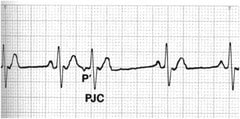
Premature Junctional Contraction
Inverted p wave or hidden p wave
PRI<0.12 or none
Normal QRS

Supraventricular Tachycardia (SVT)
an abnormal heart rhythm arising from aberrant electrical activity in the heart; originates at or above the AV node
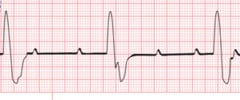
First degree heart block
atrioventricular (AV) block in which the atrial electrical impulses are delayed by a fraction of a second before being conducted to the ventricles

2nd degree heart block type 1 (Wenkebach)
Progressively longer PR interval until the P wave is not followed by a QPR

2nd Degree Heart Block (Mobitz II)
Rare, but more serious
Sudden appearance of a nonconducted P-wave
P-waves are nl, but some aren’t followed by a QRS complex
PR & RR intervals are constant

3rd degree heart block
no obvious correlation between p and qrs, need pace maker

premature ventricular contraction (PVC)
a ventricular contraction preceding the normal impulse initiated by the SA node (pacemaker)

Bigeminy PVC
every other beat is a PVC

PVC couplets
PVC occurring in pairs, no adequate C.O. when this occurs

monomorphic ventricular tachycardia
presents with wide QRS complexes of a common shape.

Torsades de pointes
Rate: 120 – 200 usually
P wave: Obscured by ventricular waves
QRS: Wide QRS – “Twisting of the Points”
Conduction: Ventricular only
Rhythm: Slightly irregular
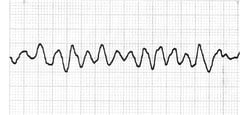
Ventricular fibrillation (V-fib)
abnormal heart rhythm which results in quivering of ventricles

Idioventricular Rhythm
<40
*looks like vtach but slow*
– no P waves (from vent foci)
– Wide QRS
(serious, death like rhythm)
– called “dying heart” rhythm…occasional ventric beat b4 death (asystole)

Accelerated Idioventricular Rhythm
Rate: 50 – 100 usually (usually slow)
P wave: Obscured by ventricular waves (occur during ventricular contraction) – SA node slower than faster ventricular pacing than should be
QRS: Wide QRS
Conduction: Ventricular only
Rhythm: Regular- benign rhythm that is sometimes seen during acute MI or early after reperfusion. – Rarely sustained, does not progress to vfib, rarely requires treatment

asystole
absence of contractions of the heart

Failure to capture (pacemaker)

failure to sense (pacemaker)

Atrial paced rhythm
spike before P wave

Ventricular paced rhythm
ventricular contractions which occur in cases of complete heart block.

Normal sinus rhythm
Regular
Rate: 60-100
P Wave: Present, upright
PR Interval: 0.12-0.20 sec
QRS: <0.12 sec

Sinus Bradycardia
Regular
Rate: <60
P Wave: Present, upright
PR Interval: 0.12-0.20 sec
QRS: <0.12 sec

Sinus Tachycardia
Regular
Rate: 100-150
P Wave: Present, upright
PR Interval: 0.12-0.20 sec
QRS: <0.12 sec
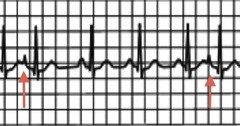
Premature Atrial Contraction
IRREGULAR
Rate: depends on underlying rhythm
P wave: Present or hidden in T wave
PR Interval: 0.12-0.20 sec
QRS: <0.12 sec

Atrial Fibrillation
IRREGULAR
Atrial rate: UNMEASURABLE
Ventricular rate: variable
P wave: unable to see
PR Interval: N/A
QRS: <0.12 sec

A fib RVR
IRREGULAR
Ventricular rate: 100-175
P wave: unable to see
PR Interval: N/A
QRS <0.12 sec

Atrial Flutter
Usually REGULAR can be irregular
Atrial rate: 250-350
Ventricular rate: variable BUT < atrial rate
P Wave: Flutter
PR Interval: N/A
QRS: <0.12 sec

Supraventricular Tachycardia
Regular
Rate: 150-350
P wave: Hidden in QRS or T wave
PR: unable to determine
QRS: <0.12 sec

Junctional Rhythm
Regular
Rate: 40-60
P Wave: ABSENT or INVERTED
PR Interval: None or <0.12
QRS: <0.12 sec

Accelerated Junctional Rhythm
Regular
Rate: 60-100
P Wave: NONE or INVERTED
PR Interval: None or <0.12
QRS: <0.12 sec

Junctional Tachycardia
Regular
Rate: >100
P Wave: NONE or INVERTED
PR Interval: None or <0.12
QRS: <0.12 sec

Premature Ventricular Contraction
IRREGULAR
Rate: refer to underlying rhythm
P Wave: NONE
PR Interval: N/A
QRS: WIDE and BIZARRE , >0.12 sec

Ventricular Tachycardia
Regular
Rate: >100
P Wave: NONE
PR Interval: N/A
QRS: WIDE and BIZARRE, >0.12 sec
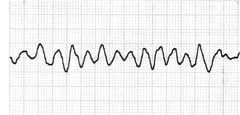
Ventricular Fibrillation
Chaotic
Coarse: big waves
Fine: small waves
Rate: unmeasurable
P Wave: NONE
PR Interval: N/A
QRS: N/A

Idioventricular
Regular
Rate: 20-50
P wave: NONE
PR Interval: N/A
QRS: WIDE, >0.12 sec
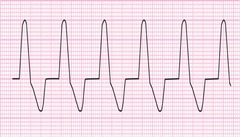
Accelerated Idoventricular Rhythm
Regular
Rate: 50-100
P wave: NONE
PR Interval: N/A
QRS: WIDE, >0.12 sec
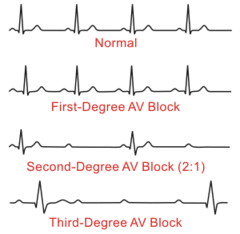
1st Degree AV Block
Regular
Rate: 60-100
P Wave: Present, upright
PR interval: >0.20 sec CONSISTENTLY LONG
QRS: <0.12 secHusband stays late till 9 consistently

2nd Degree AV Block Type I Mobitz, Wenckebach
IRREGULAR
Rate: 60-100
P wave: Present, upright
PR Interval: Progressively longer until drop (PR interval longer and longer until drop)
QRS: <0.12 secHusband stays late till 9, then 11, then 1, then doesn’t come home at all
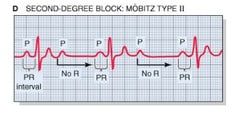
2nd Degree AV Block Type II
Irregular or regular
Rate: <60
P wave: Present, upright
PR Interval: PR interval consistently LONGER like type 1 but then a QRS will drop
QRS: <0.12 secHusband stays late till 9 consistently, then wife goes out and doesn’t come home

3rd Degree AV Block
Atrials and ventricles don’t communicate
Rate: regular atrial
P wave: Present, upright
No relationship between P waves and QRS
PR Interval: VARIABLE
QRS: variableP-P ad R-R consistent but NO correlationHusband and wife live separate lives and don’t communicate
SA Node
1st
60-100
AV Node
2nd
40-60
Bundle of His
3rd
40-45
Right and Left Bundle Branches
4th
40-45
Purkinje Fibers
5th
20-50
1 Small Box
0.04 sec
1 Big Box
0.20 sec
Junctional Rhythms
SA Node DID NOT FIRE
AV Node fired
NO P WAVE bc SA node didn’t fire
Narrow QRS
P Wave
Amplitude 0.5-2.5 mm
Will be shorter than T wave
Shows firing of SA node
QRS
0.06-0.10 sec SHOULD BE <0.12 sec
Wide QRS: delay in ventricular contraction, delay of conduction through bundle branches or purkinje fibers
BUNDLE BRANCH BLOCK or BLOCK IN PURKINJE FIBERS (idioventricular)
Calculate Regular Rate
1500/ # boxes R-R
Calculate Irregular Rate
# of Rs in 6 sec strip X 10

Unifocal PVCs
Only 1 shape PVC
Bigeminy
PVC occurs every OTHER beat
Trigeminy
PVC occurs every THIRD beat
Couplet
2 PVCs together
Triplet
3 PVCs together
Multifocal
Multiple shapes

Monomorphic V Tach
Same Shapes V Tach

Polymorphic V Tach
Different Shapes V tach

Coarse V Fib
Chopy but not as high as polymorphic V tach

Fine V Fib
Fine and fibrillatory
Idioventricular Rhythms
Only purkinje fibers firing
WIDE QRS always
Atrially Paced
Spike comes before P
Ventricularly Paced
Spike comes before QRS and QRS will be wide
AV Paced
Spike before P and before QR

Failure to Capture
Spikes with no QRS

Failure to Sense
Spikes happen regardless of QRS on their own
How to determine the rhythm
Regular or irregular?
Rate?
P before every QRS? QRS for every P?
QRS wide or narrow?
QT Interval
0.34-0.43
P Wave
0.06-0.12 sec
PR Interval
0.12-0.20 sec
SA Node Firing Rhythms
*Fires normally @ 60-100*
-SR 60-100
-SB <60
-ST 100-150
-SVT 150-350
AV Node Firing, SA Node Failed Rhythms
*Fires normally @ 40-60*
-Junctional rhythm 40-60
-Accelerated junctional rhythm 60-100
-Junctional tachycardia 100-150
Only Purkinje Fibers Firing Rhythms (Everything else has failed)
*Fires normally @ 20-50*
-Idioventricular 20-50
-Accelerated idioventricular 50-100
